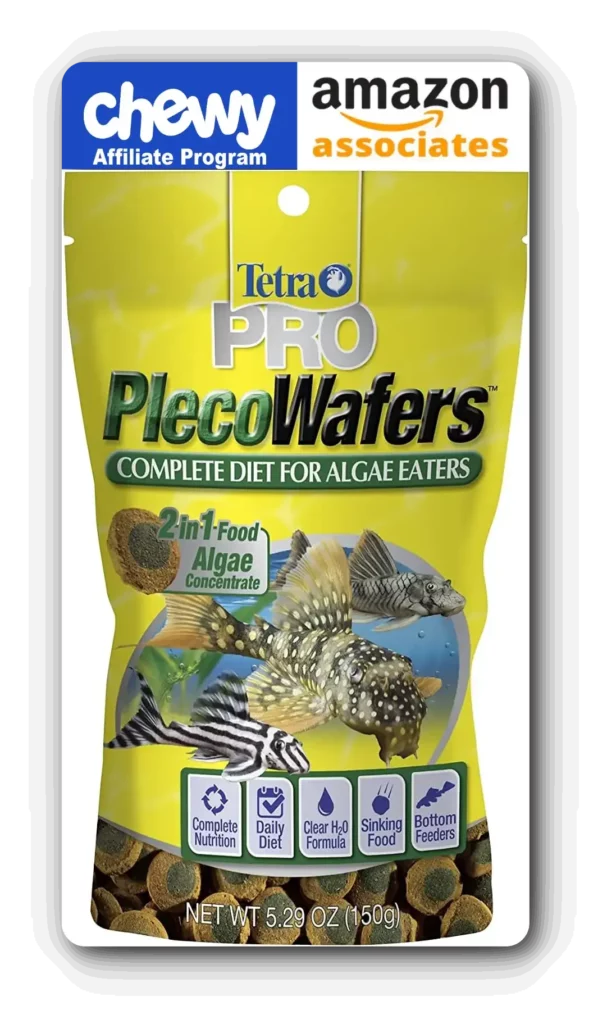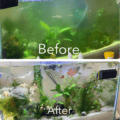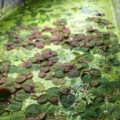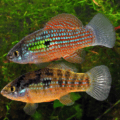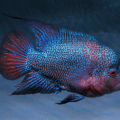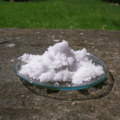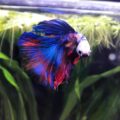Get the best tips for pet Juvenile Chinese Algae Eaters’ care and ensuring a long and healthy life from baby through adulthood including premium algae-based dietary suggestions, tank setup, health care, and even breeding.

Introduction
Today’s aquarium review takes a different approach because of the nature of this freshwater algae-eating fish: Gyrinocheilus aymonieri, or Juvenile Chinese Algae Eater. This species has a healthy algae-eating habit during its early life. Seasoned aquarists and beginners must understand the separate maintenance procedures for adults and young Juvenile Chinese Algae Eater fish, more details on this later.
This Gyrinocheilus aymonieri overview provides relevant Juvenile Chinese Algae Eater care tips to help this species survive; you’ll learn about their energy, adaptability, and tank suitability so that even beginner aquarists can succeed in caring for them.
See Also: 20 Hair Algae Eaters for a SPOTLESS Aquarium for more algae eating fish!
The Appearance of Juvenile Chinese Algae Eaters
Identifying Juvenile Chinese Algae Eaters starts with understanding that the adults and fry look different. Juvenile Chinese Algae Eater have a sleek, elongated body that’s only 2.5 – 5cm long, but their uniqueness truly shines through their color and behavior.
Color Pattern
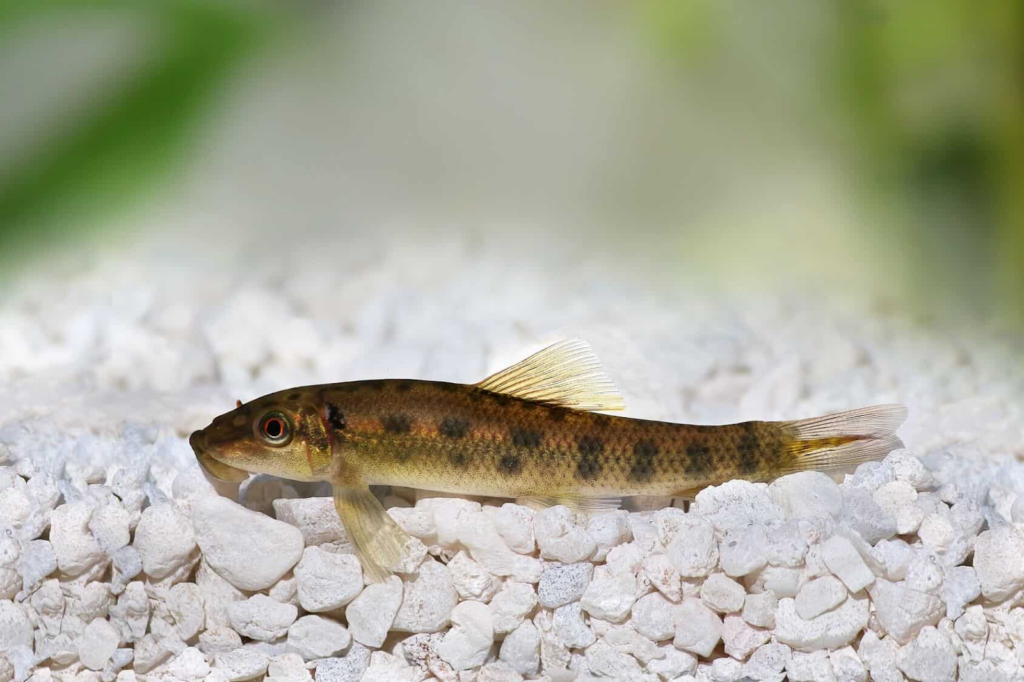
Young Chinese Algae Eaters have an earthy golden or brown color with a signature black pattern. These Algae eater fish patterns vary from lateral stripes to motts and spots, depending on genetics and other care factors you’ll soon learn.
Color Pattern

- Chinese Algae Eater:
- An elongated body shape and can grow larger, reaching lengths of up to 6-10 inches (15-25 cm) when fully grown.
- Dark brown or blackish body with a golden-yellow coloration on their underside.
- They have a sucker mouth that is often used to attach to surfaces.
- Siamese Algae Eater:
- Generally smaller than Chinese Algae Eaters, reaching lengths of 2-4 inches (5-10 cm) when fully grown.
- They have a slender body shape with a silver or greyish coloration and a black horizontal stripe running from their head to the tail.
- They also have a sucker mouth.
Unique Traits
Juvenile Chinese Algae Eaters have a suckermouth with barbels that help them cling to the surface while grazing for algae. Their streamlined bodies and rounded heads encourage their active swimming behavior.
These pets also have eyes with dark pupils and metallic rings that tilt upwards to help them observe their surroundings while grazing.
Setting Up the Perfect Aquarium for Juvenile Chinese Algae Eaters
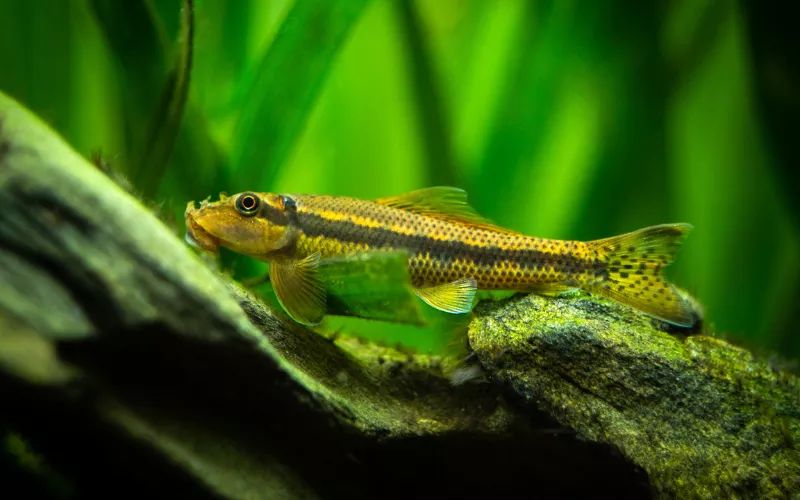
So far, you’ve seen that this species grazes on algae a lot, so it’s normal for you to build a Juvenile Chinese Algae Eater tank setup that encourages algae growth. Remember that the design must also be specific to juveniles, not adult Chinese Algae Eaters as these fish become omnivorous when fully mature. They still need clean water, hiding spots, and moderate flow, so here’s how to accommodate, up next.
Tank Size and Layout
Get a minimum tank size of 30 gallons with the decor and other fittings. Then, the layout will mimic the natural Gyrinocheilus habitat design. You can do this with smooth substrates and hiding areas essential to a Juvenile Chinese Eater’s survival.
Keep reading for the specifics.
Water Parameters
| Suitable Temperature | 74 – 80℉ |
| pH Level | 6 – 7.5 |
| Hardness | Soft to Moderately Hard (2 – 15 dGH) |
Decor Essentials
Here’s where you can get creative and build an immersive pet aquarium. Rocks, caves, and driftwood are decor essentials for recreating a Juvenile Chinese Algae Eater’s natural habitat. The caves give them a hiding spot as they grow, while driftwood encourages algae growth for grazing.
Feeding Juvenile Chinese Algae Eaters: Supporting Their Growth
Juvenile Chinese Algae Eaters rely on an algae-based fish diet but also need supplemental foods. Use this Gyrinocheilus nutrition guide to ensure they get all the nutrients they need for optimal development and growth.
Diet Suggestions
Their primary diet should be algae, sinking algae wafers, and biofilm. Supplement these with spirulina-based foods and occasional blanched vegetable slices because their preference will switch to an omnivorous diet as they grow.
Feeding Tips
Feeding Juvenile Chinese Algae Eaters in small amounts throughout the day helps to mimic natural grazing behavior and control their portions.
For more on feeding your aquatic pets check out The Ultimate Guide to Fish Food: Pros and Cons & Best Choices!
Choosing Compatible Tank Mates for Juvenile Algae Eaters
Juvenile Chinese Algae Eaters are peaceful, but as they mature, they become aggressive. That’s why choosing compatible freshwater fish species for them is a delicate act. You must find peaceful community fish or other species and prepare to switch them out as your pets mature.
See Also: 10 Freshwater Fish That Will Help Clean Your Tank for fish that work double time to clean your tank!
Compatible Species
Juvenile Chinese Algae Eater tank mates should have similar sizes, the same environmental needs, and peaceful temperaments.
| Tetras | |
| Rasboras | |
| Peaceful Loaches (Panda Loaches, Dojo Loaches, Kuhli Loaches) |
Avoided Species
Avoid aggressive or territorial fish because your algae eaters will become aggressive as they mature. Also, keep slow, smaller, or larger fish away to prevent bullying.
Lifespan of Juvenile Chinese Algae Eaters: Care Tips for Longevity
You can maximize your Juvenile Chinese Algae Eater lifespan up to 5 – 10 years with proper care, stable water conditions, and a balanced diet by following all the freshwater fish health tips in this guide.
Note the important factors you must focus on because they influence your pet’s well-being.
- Lifespan Factors: Maintaining pristine water quality, regular feeding routines, and a stress-free environment will give your Juvenile Chinese Algae eater a long life.
- Care Tips for Longevity: You can ensure the best of these lifespan factors by providing long-term care for Gyrinocheilus. Provide routine tank maintenance by feeding your pets daily, cleaning their leftover foods, changing 20 – 30% of the water weekly, and monitoring for illnesses.
Behavioral Changes as Juvenile Chinese Algae Eaters Mature
Chinese Algae Eaters have a major behavioral shift from Juvenile to adulthood. These freshwater fish behavior insights will help you decide whether you want this species as a juvenile or an adult.
Juvenile Behavior
If you need natural algae cleaners, you’ll appreciate the early behavior of Juvenile Chinese Algae Eater fish. This is also the best time to add them to a community tank because they’re more friendly and social at this stage.
Adult Behavior
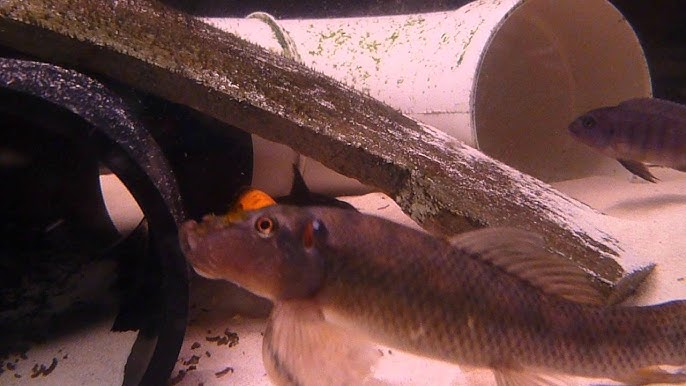
Some algae eater maturity changes you’ll notice include territoriality, less reliance on an algae diet, and a more omnivorous-focused nutrition.
Preventing Common Health Issues in Juvenile Chinese Algae Eaters
Health care for Juvenile Chinese Algae Eaters is similar to that of adults, but there are slight differences because of their age. They may face common health concerns, such as stress, poor water quality, overfeeding, and malformation.
These freshwater fish wellness tips will help you prevent diseases, provide optimal health care, and give first aid treatment to your Juvenile Chinese Algae Eaters if they get sick regardless.
Preventative Measures
Preventing aquarium fish diseases starts with maintaining clean water and building an optimal environment with proper tank mates. Then, you must ensure your pets eat balanced diets, regardless of their preferences. Scroll up for dietary tips.
Signs of Illness
Remember that I recommended periodic observation to maximize your pet’s lifespan. Here are the symptoms to look for:
- Discoloration: A sign of malnutrition, poor water quality, and infection.
- Lethargy: A sign of stress and possible parasitic infection.
- Fin Damage: A sign of bad decor, aggressive tank mates, or malnutrition.
Conclusion
Every level of aquarist looking for a natural tank cleaner will love this freshwater algae-eating fish. Remember that the juveniles get the job done because adult Chinese Algae Eaters don’t rely on algae diets.
This Juvenile Chinese Algae Eater care guide shows you all the best ways to manage this active fish’s personality, interests, and lifestyle. You won’t regret adding these dynamic and useful juveniles to your tanks, even though it’ll require a little extra dedication.
If you feel overwhelmed, you can return to this guide for simple Gyrinocheilus aquarium tips to help give your pets the best life for 5 – 10 years!

